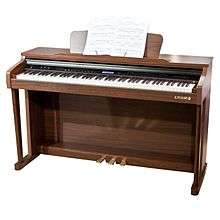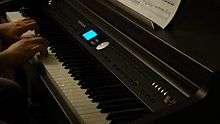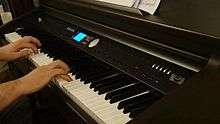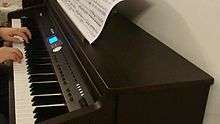Digital piano

A digital piano (not to be confused with electric piano and electronic piano), also known as piano synthesizer, portable piano, weighted keyboard, or in the late 1980s, personal electronic piano, is a modern electronic musical instrument; a variation of electronic keyboard or synthesizer designed to serve primarily as an alternative to the traditional acoustic piano, both in the way it feels to play and in the sound produced. It is intended to provide an accurate simulation of an acoustic piano. Some digital pianos are also designed to look like an acoustic piano, both the upright or grand piano body style. Digital pianos use either an electronic synthesized emulation of the piano sound or a sampled piano sound, which is then amplified through an internal loudspeaker. Digital pianos typically have weighted or semi-weighted keyboards, which attempt to recreate the feel of an acoustic piano.
While digital pianos may sometimes fall short of a real piano in feel and sound, they nevertheless have other advantages over acoustic pianos. Digital pianos cost much less than an acoustic piano and most models are much smaller and lighter in weight than an acoustic piano. As well, digital pianos do not need to be tuned, and their tuning can be modified to match the tuning of another instrument (e.g., a pipe organ). Since digital pianos produce their sound electronically, the volume can be made louder or softer using a volume control. Digital pianos can be connected to a keyboard amplifier or PA system to produce a sound loud enough for a large venue. At the same time, most digital pianos can be played using headphones, which means that they are quiet enough for practicing in an apartment or hotel room. Some digital pianos can also emulate other sounds besides the piano, the most common ones being pipe organ, electric piano, Hammond organ and harpsichord. Digital pianos are often used in school and amateur performances to replace traditional instruments.[1]
Features
The following is a list of features that typify the digital piano:
- Sound level/volume knobs, headphone outputs.
- Typically low maintenance, unlike acoustic pianos.
- Many incorporate a MIDI implementation.
- May have features to assist in learning and composition
- They often have a transposition feature
- They do not require the use of microphones
- Are often easily portable
- Depending on the individual features of each digital piano, they may include many more instrument sounds other than regular piano samples. Many less expensive or average-priced digital pianos often include basic instruments such as string ensemble, electric piano, organs, harpsichord, guitar, and vibraphone, while a more expensive and advanced digital pianos may have a wider range of instruments such as synthesized sounds, wind instruments, traditional instruments, violins, drums, percussion, and a variety of effects, similar to that of a typical digital keyboard or synthesizer. Some digital pianos may also have a complete set of General MIDI implementation, in addition to the aforementioned basic sounds.
- Typically feature weighted keys to mimic the feel of a traditional piano, thus earning the term weighted keyboard.
- In addition, most digital pianos often incorporate a simulated key weight mechanism in which the lower notes feel heavier than the higher notes, vaguely replicating the feel of an actual piano.
Sounds




In most implementations, a digital piano produces a variety of piano timbres and usually other sounds as well. For example, a digital piano may have settings for a concert grand piano, an upright piano, a tack piano, and various electric pianos such as the Fender Rhodes, the Wurlitzer, and the DX electric piano. Some digital pianos incorporate other basic "synthesizer" sounds such as string ensemble, for example, and offer settings to combine them with piano.
In general, the sounds produced by a digital piano are based on sampling, by which real piano sound samples are stored in ROM. The samples stored in digital pianos are usually of very precision recording and made using high-quality pianos, expensive microphones, and high-quality preamps in a professional recording studio.[2] ROM may include multiple samples for the same keystroke, attempting to reproduce diversity observed on the real piano, but the number of these recorded alternatives is limited.
Sample-based digital pianos do have limitations on the faithfulness with which they reproduce the sound of an acoustic piano. These might include the lack of implementation of harmonic tones that result when certain combinations of notes are sounded, limited polyphony, and a lack of natural reverberation when the instrument is played percussively. They often lack the incidental acoustic noises associated with piano playing, such as the sounds of pedals being depressed and the associated machinery shifting within the piano, which some actually consider a benefit. These limitations apply to most acoustic instruments and their sampled counterparts, the difference often being described as "visceral". On an acoustic piano, the sustain pedal lifts the dampers for all strings, allowing them to resonate naturally with the notes played. Digital pianos all have a similar pedal switch to hold notes in suspension, but only high-end models can reproduce the sympathetic resonance effect.
Also, because piano sound samples are taken for only a limited number of intensity levels, digital pianos usually lack the continuous timbral changes that characterizes real acoustic pianos.
Earlier digital pianos, such as those produced in the 1990s, often had its polyphony limited to only 32 or 64 notes, and its sampling system were comparable to standard home keyboards.
Some digital piano implementations, like Roland's V-Piano[2] and the software-based Pianoteq, use mathematical models based on real pianos to generate sound, which brings the ability to generate sounds that vary more freely depending on how the keys have been struck, in addition to allow a more realistic implementation of the distinctive resonances and acoustical noises of real pianos.
However, with the technological advances, recent digital pianos are mostly capable of recreating string resonances, reverberations and other acoustical effects via digital signal processing (DSP) and modeling technology. One example is the Casio Privia, which is able to generate such acoustical effects by means of a simple DSP, which is far less complex than physical modeling.
Other
Most digital pianos implement a variety of features not found on a traditional piano.
Digital pianos usually offer a MIDI connection, allowing them to control or be controlled by other electronic instruments and sequencers. They may also have an external storage slot to save and load MIDI data, which the piano can play automatically, allowing it to function as a player piano.
Some have a built-in sequencer to aid in composition.
they may have illuminated keys so that a beginner can learn a piece by playing keys that are lit.
Some can transpose music as it is played, allowing the pianist to play in a familiar key while the piano renders it in another.
An acoustic piano produces reverberation in its soundboard and in the room where it is played. Digital pianos often have a feature to electronically simulate reverberation as well. Other digital pianos may have additional reverberation options such as a "stage simulation." Some also have chorus, tremolo, and phaser effects, all of which are generated by digital signal processing.
Some offer additional sounds; common ones are string instruments, harpsichord, organ, clavichord, and electric piano.[3]
A more expensive and advanced digital pianos often share similar characteristics to electronic keyboards, which encompasses a more diverse range of sounds. A digital piano that offer a wide variety of instrument sounds is generally called an ensemble digital piano, or just ensemble piano.
Digital pianos typically use analog sensors for its keyboard action, as opposed to digital sensors of a regular keyboard and synthesizer. These sensors notably works in a similar way to those used in analog joysticks found on video game controllers, in which they the velocity input is converted from the key movement as well, not just the initial pressure of the key sensor.
Since the inception of the MIDI interface standard in the early 1980s, most digital pianos can be connected to a computer. With appropriate software, the computer can handle sound generation, mixing of tracks, music notation, musical instruction, and other music composition tasks.[4]
Construction and components
The physical form of a digital piano can vary considerably, with a keyboard as the one constant feature.
Shape and form

Console type
Most console digital pianos vaguely resemble an electronic organ or a spinet harpsichord but usually lacking a fully enclosed lower section, while some models are based on the casework of traditional upright pianos with a fully enclosed bottom part and pedals that look like actual piano pedals. An opposite and recent trend is to produce an instrument which has a unique and distinctive appearance, unobtainable with a conventional instrument. Yamaha and Casio makes a model which is designed to stand against a wall and is far shallower from keyboard to back than any possible upright design, as well as shorter height.
Console digital pianos, due to its form, offers less portability than the other types, and is mainly designed for use in single place (e.g. home or studio), and not intended for mobility such as on stage or for live performance.
Upright type
These are a sub-type of console digital pianos that offers a more contemporary design which closely resemble a traditional upright piano. Upright digital pianos are mainly intended for home use, and is usually more expensive than the other types. Some models, especially the higher-end ones, often feature an actual wooden keys as opposed to regular plastic keybed.
Grand type
An uncommon form of digital piano that resemble a grand piano cabinet, usually with a more precision keyboard action and high-quality sound system built into the cabinet in a similar manner as the strings on an actual grand piano. These pianos are mostly premium novelty models offered by only small number of manufacturers, and often has higher prices than an average upright piano.
Stage piano
Another common form is the stage piano, designed for use with live performances, professional audio, or in recording studio. This type of digital piano normally makes no attempt to imitate the physical appearance of an acoustic piano, rather resembling a modern synthesizer or music workstation. A distinguishing feature of most stage pianos is a lack of internal loudspeakers and amplification - it is normally assumed that a powerful keyboard amplifier or PA system will be used. However, some stage pianos are unique that it is remain equipped with powered speakers.
Examples of stage pianos include Roland RD series, Casio Privia Pro, and Yamaha CP series. Yamaha P-250 is an example of a stage piano with unique speakers.
Portable type
Yet another form is the portable digital piano which is what appear to be combining the versatility of stage pianos, but with portability and features similar to a conventional digital keyboard. These digital pianos are mostly designed for various purposes such as home, studio, classroom, stage or personal use. It is similar in form to a stage piano, but much lighter in weight, and having a more compact size. Unlike stage pianos, portable digital pianos were commonly equipped with average-powered internal loudspeakers, usually has lower cost than other types, and its sound quality were often comparable or similar to that of a regular digital keyboards due to a simpler sound synthesis system, though some models, still utilize a similar sound engine as the more advanced model lineups of the same manufacturer.
Most portable digital pianos could be freely fitted in a regular keyboard stand like a stage piano, while some types also come equipped with a dedicated matching stand which, when assembled, will have a slight resemblance to a console digital piano.
Portable digital pianos, for the sake of lower production cost, were often equipped with a less complex system for the weighted keys. As a result, the feel of the keys is usually much less realistic than other digital pianos. However, it still retain the emulated weight mechanism (lower keys are heavier than higher ones), though not as precision as more expensive pianos. However, certain models include synthetic ivory-like keys as opposed to standard plastic keys.
Many examples of portable digital pianos are mostly those usually produced by Yamaha, Korg, and Casio under the $900 price range. Kawai has also recently competed within the low-cost digital piano class as of early 2015.
Piano module
There are also digital piano modules, which are simply keyboardless sound modules chiefly containing piano samples. One early example of a digital piano module is the Roland MKS-20 Digital Piano.
Pianoteq is a software synthesizer which share some characteristics to a piano module.
Keyboard and pedals
Just like a traditional piano, a digital piano features a keyboard. A digital piano's keyboard is weighted to simulate the action of a traditional piano and is velocity sensitive so that the volume of the sounds depends on how hard the keys are pressed. Many instruments now have a complex action incorporating actual hammers in order to better simulate the touch of a grand piano.[5]
Many digital pianos, especially those that resemble an acoustic piano, have built-in pedals that function much as those on an acoustic piano.
In addition, commercially available pedal switch that is commonly used for regular keyboards can also be used, especially on portable models.
Maintenance
Unlike acoustic pianos, digital pianos normally maintenance-free and are less prone to be affected by unusual conditions. However, those that have a sophisticated features like an advanced mechanical action for the keys, still require special maintenance to keep the action in normal working condition, especially if used for an extended periods of time since digital piano action are prone to become loose or less rigid over time, reducing its sensitivity and response.
As an electronic instrument, digital pianos doesn't need to be tuned as their sound are produced electronically, yet the sound quality may be affected over time or under extreme conditions, such as the change of quality of the built-in speakers.
Manufacturers
Manufacturers continue to develop technology for both sound and feel covering a wide range of quality and cost. Well-known manufacturers of digital pianos include Casio, Clavia, Kawai, Korg, Kurzweil, Roland, and Yamaha.
See also
References
- ↑ Skinner, Alden. "A Brief History of Digital Pianos." A Natural History of the Piano: The Instrument, the Music, the Musicians--from Mozart to Modern Jazz and Everything in Between by Stuart Isacoff. Knopf Doubleday, 2012. 305. Print.
- 1 2 "Roland V-Piano". Soundonsound.com. Retrieved 2014-05-12.
- ↑ "Beyond the Acoustic Piano". Digital Piano Basics, Part 2. Acoustic & Digital Piano Buyer. Spring 2012. p. 128. Retrieved 25 July 2013.
- ↑ Taylor, Ben (23 Jan 2014). "The Definitive Guide to Digital Pianos". Time. Retrieved 2 April 2015.
- ↑ "Behringer Eurogrand EG8080" Canadian Musician Jul/Aug2006, Vol. 28 Issue 4, p72. EBSCOhost: Academic Search Premier. Accessed December 16, 2007
- Love, Tom. "Why a digital piano?". Kawai. Retrieved 2 April 2015.
- Roland. "Digital pianos FAQ". Roland. Retrieved 2 April 2015.
- The HUB (15 December 2014). "Digital Piano Buying Guide". Musician's Friend. Retrieved 2 April 2015.
External links
- BosendorferImperial.com - includes history of the 290SE (first reproducing computer controlled pianos developed in 1978), their modern CEUS system, with complete audio files of songs & images.